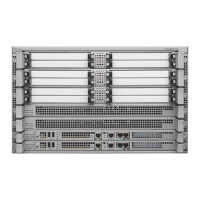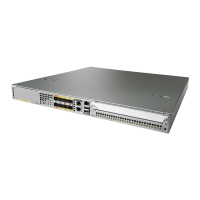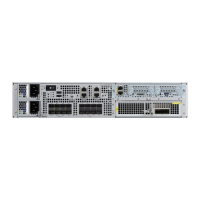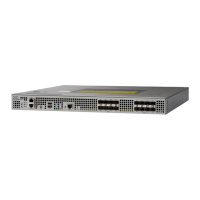The following example shows that SONET payload scrambling is disabled for interface port 0 on the POS
SPA installed in subslot 0 of the SIP that is located in slot 2 of the Cisco ASR 1000 Series Routers:
Router# show interfaces pos 2/0/0
Hardware is Packet over Sonet Internet address is 10.0.0.1/24 MTU 9216 bytes, BW 622000
Kbit, DLY 100 usec, reliability 255/255, txload 1/255, rxload 1/255 Encapsulation HDLC,
crc 16, loopback not set Keepalive not set Scramble disabled
Configuring the Encapsulation Type
By default, the POS interfaces support High-Level Data Link Control (HDLC) encapsulation. The encapsulation
method can be specified as HDLC, Point-to-Point Protocol (PPP), or Frame Relay. The encapsulation type
must be configured to be the same on both ends of the POS link.
To modify the encapsulation method, use the following command in interface configuration mode:
PurposeCommand
Specifies the encapsulation method used by the
interface, where:
•
encapsulation-type— Can be HDLC, PPP, or
Frame Relay. The default is HDLC.
Router(config-if)# encapsulation encapsulation-type
Verifying the Encapsulation Type
To verify the encapsulation type, use the show interfaces pos privileged EXEC command and observe the
value shown in the “Encapsulation” field.
The following example shows the encapsulation type is HDLC for port 0 on the POS SPA installed in subslot
0 of the SIP that is located in slot 2 of the Cisco ASR 1000 Series Router:
Router# show interfaces pos 2/0/0
Hardware is Packet over Sonet Internet address is 10.0.0.1/24 MTU 9216 bytes, BW 622000
Kbit, DLY 100 usec, reliability 255/255, txload 1/255, rxload 1/255 Encapsulation HDLC
, crc 16, loopback not set Keepalive not set Scramble disabled
Configuring POS Alarm Trigger Delays
A trigger is an alarm that, when activated, causes the line protocol to go down. The POS alarm trigger delay
helps to ensure uptime of a POS interface by preventing intermittent problems from disabling the line protocol.
The POS alarm trigger delay feature delays the setting of the line protocol to down when trigger alarms are
received. If the trigger alarm was sent because of an intermittent problem, the POS alarm trigger delay can
prevent the line protocol from going down when the line protocol is functional.
Path-Level Triggers
You can issue the pos delay triggers path command to configure various path alarms as triggers and to
specify an activation delay between 0 and 10000 milliseconds. The default delay value is 100 milliseconds.
Cisco ASR 1000 Series Aggregation Services Routers SIP and SPA Software Configuration Guide, Cisco IOS
XE Everest 16.5
202 OL-14127-17
Configuring the POS SPAs
Configuring the Encapsulation Type
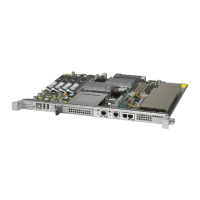
